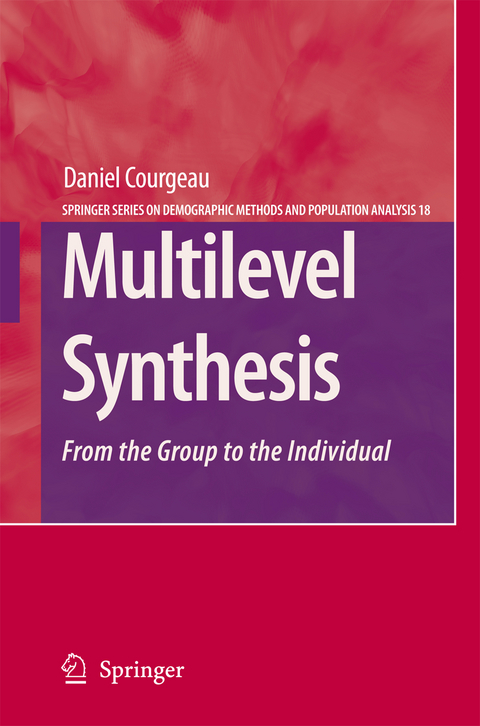
Multilevel Synthesis
Springer (Verlag)
978-90-481-7410-2 (ISBN)
From Macro/Micro Opposition to Multilevel Analysis.- Period Analysis of Social Groups.- of Seniority in the Group.- Analyzing Individual Data.- Toward a Contextual and Multilevel Analysis.- Multilevel Analysis.- Defining Levels.- Linear Analysis of Continuous Characteristics.- Analysis of Discrete Characteristics.- Multilevel Event-History Analysis.
From the reviews:
"This book represents a pioneer demographic synthesis of the intricacies and richness of multilevel analysis of retrospective, cross-sectional, longitudinal, or event history data. It should help readers’ better grasp of key features of multilevel regression. Specific linear, nonlinear and survival models and their corresponding mathematical and statistical equations are presented in a straightforward manner by avoiding unnecessary technical details that could sidetrack some readers. This should allow for quick comparisons by readers and help them to conceptualise and understand better multilevel analysis. This book is primarily targeted at social science scientists, students and scholars interested in population investigation. I have no doubt that individuals who are interested in learning multilevel modelling will find this book to be an invaluable asset.
… Courgeau’s volume is a neatly written book on mathematical and statistical applications in population studies that I have no hesitation recommending for advanced training and research in demography as well as for scholars unfamiliar with multilevel modelling. It firmly establishes what we have been advocating in classrooms and research settings, namely that mathematical statistics married with theoretical and empirical representation of population processes is a necessary ingredient for widening the frontiers of demography as a discipline." (Barthelemy Kuate-Defo, University of Montreal, Canada in the European Journal of Population)
"The book displays the following strengths:
Consistency: The author has achieved coherence and perfect homogeneity.
Mathematical exactness: Each of the numerous models is expressed mathematically; the consequences of each model are clearly presented, also in mathematical language. This removes all ambiguity regarding the substance of the issuesraised.
Usefulness: The author uses ten examples drawn from different surveys—in particular, migration surveys—to apply each method and model described. The same "concrete examples" thus recur in several chapters, treated with successive methods. The data tables are provided, as well as the statistical parameters to show how the model fits the data. In every respect, this volume offers a perfect example of what mathematical social science should be: data and questions about them; mathematical formalization; application of the model, with the statistical apparatus required to appreciate the relevance of the theory. In addition, an abundance of very clear charts and tables allows the reader, or the student, to follow the whole process in great detail.
Historical aspect: Demography and its methods have a history that is always present in the volume, each step in the development of methods being explained by the previous steps. The last chapter discusses future prospects, notably as regards new data sources to be established.
In its present form, this volume will serve henceforth as the reference book on multilevel analysis […]. As such, it should be found in every library on social science methodology and statistics." (Translated excerpt of a book review (in French) in Mathematics and Social Sciences, by Marc Barbut, Editor)
"On the one hand it a textbook, and on the other it constitutes an assessment of multilevel analysis which tackles one of the major problems of demography and sociology: how analysis at the individual and group levels can be integrated. Indeed one of the aims of this textbook is to demonstrate how a multilevel approach can resolve some of the contradictions that have become apparent in the evolution of demographic thought and achieve a synthesis of the different approaches employed." (Genus, Antonio Golini,Editor)
"This manuscript will yield a consummate book—the outcome of a research project that has matured over many years. In essence, it is both a textbook and an evaluation of multilevel analysis that tackles the most significant challenge of empirical sociology: how to integrate analyses at the individual and group levels.
The author’s theoretical and epistemological approach to this problem is particularly elegant. He takes us back to the foundations of sociology, then leads the discussion up to very recent examples. Rigorous in its arguments, the text manages to be accessible to a newcomer in the field yet is free of the simplifications that would turn away a specialist in social sciences.
The methodological exposition is particularly clear. Numerous examples, recurring throughout the volume, make the reading easier. The formal exposition is accessible to anyone concerned with demography, and the author examines practical difficulties very lucidly with no attempt to conceal them." (Translation excerpt from an anonymous referee’s report (in French)
"A ‘textbook [that] presents a historical panorama of the evolution of demographic thought from its seventeenth-century origins up to the present day’ … . The book’s structure and arguments are entirely appropriate – the reader is gently led towards the case for multilevel modelling in a coherent way. … There is considerable richness in this book that will reward detailed study … ." (Ron Johnston, Regional Studies, Vol. 42 (3), 2008)
| Erscheint lt. Verlag | 25.11.2010 |
|---|---|
| Reihe/Serie | The Springer Series on Demographic Methods and Population Analysis ; 18 |
| Zusatzinfo | XXX, 228 p. |
| Verlagsort | Dordrecht |
| Sprache | englisch |
| Maße | 155 x 235 mm |
| Themenwelt | Geisteswissenschaften ► Philosophie ► Erkenntnistheorie / Wissenschaftstheorie |
| Naturwissenschaften | |
| Sozialwissenschaften ► Soziologie ► Empirische Sozialforschung | |
| Sozialwissenschaften ► Soziologie ► Spezielle Soziologien | |
| ISBN-10 | 90-481-7410-4 / 9048174104 |
| ISBN-13 | 978-90-481-7410-2 / 9789048174102 |
| Zustand | Neuware |
| Haben Sie eine Frage zum Produkt? |
aus dem Bereich

![Was heißt Denken?. Vorlesung Wintersemester 1951/52. [Was bedeutet das alles?] - Martin Heidegger](/media/113619842)
